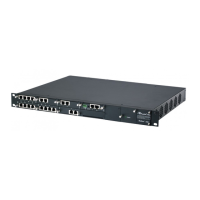Version 7.2 369 Mediant 500L Gateway & E-SBC
User's Manual 17. Control Network
Parameter Description
The reason for preferring classification based on Proxy Set when the IP
address is unknown is that IP address forgery (commonly known as IP
spoofing) is more difficult than malicious SIP message tampering and
therefore, using a Classification rule without an IP address offers a
weaker form of security. When classification is based on Proxy Set, the
Classification table for the specific IP Group is ignored.
If you have assigned the same Proxy Set to multiple IP Groups, disable
the parameter and instead, use Classification rules to classify incoming
SIP dialogs to these IP Groups. If the parameter is enabled, the device
is unable to correctly classify incoming INVITEs to their appropriate IP
Groups.
Classification by Proxy Set occurs only if classification based on the
device's registration database fails (i.e., the INVITE is not from a
registered user).
SBC Operation Mode
sbc-operation-mode
[IPGroup_SBCOperatio
nMode]
Defines the device's operational mode for the IP Group.
[-1] Not Configured = (Default)
[0] B2BUA = Device operates as a back-to-back user agent (B2BUA),
changing the call identifiers and headers between the inbound and
outbound legs.
[1] Call Stateful Proxy = Device operates as a Stateful Proxy, passing
the SIP message transparently between inbound and outbound legs. In
other words, the same SIP dialog identifiers (tags, Call-Id and CSeq)
occur on both legs (as long as no other configuration disrupts the CSeq
compatibleness).
For more information on B2BUA and Stateful Proxy modes, see B2BUA
and Stateful Proxy Operating Modes on page 640.
Note: If configured, the parameter overrides the 'SBC Operation Mode'
parameter in the SRDs table.
SBC Client Forking
Mode
sbc-client-forking-mode
[IPGroup_EnableSBCCl
ientForking]
Defines call forking of INVITE messages to up to five separate SIP
outgoing legs for User-type IP Groups. This occurs if multiple contacts are
registered under the same AOR in the device's registration database.
[0] Sequential = (Default) Sequentially sends the INVITE to each
contact. If there is no answer from the first contact, it sends the INVITE
to the second contact, and so on until a contact answers. If no contact
answers, the call fails or is routed to an alternative destination, if
configured.
[1] Parallel = Sends the INVITE simultaneously to all contacts. The call
is established with the first contact that answers.
[2] Sequential Available Only = Sequentially sends the INVITE only to
available contacts (i.e., not busy). If there is no answer from the first
available contact, it sends the INVITE to the second contact, and so on
until a contact answers. If no contact answers, the call fails or is routed
to an alternative destination, if configured.
Note: The device can also fork INVITE messages received for a Request-
URI of a specific contact (user) registered in the database to all other users
located under the same AOR as the specific contact. This is configured
using the SBCSendInviteToAllContacts parameter.
Advanced
Local Host Name
local-host-name
Defines the host name (string) that the device uses in the SIP message's
Via and Contact headers. This is typically used to define an FQDN as the

